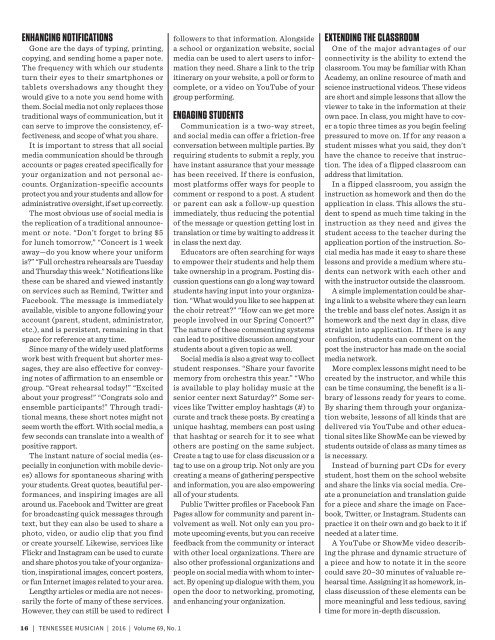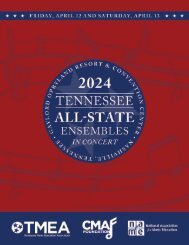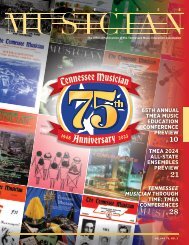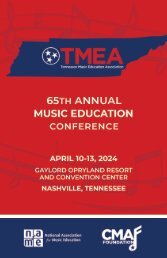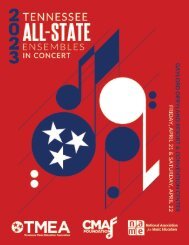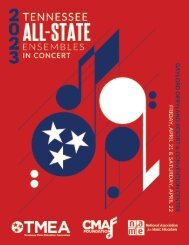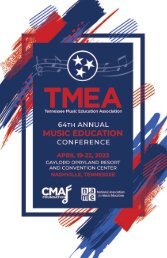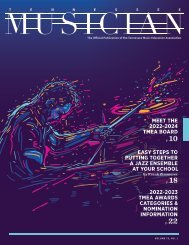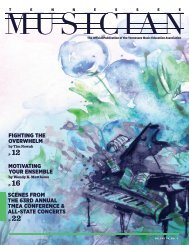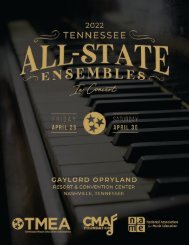Create successful ePaper yourself
Turn your PDF publications into a flip-book with our unique Google optimized e-Paper software.
ENHANCING NOTIFICATIONS<br />
Gone are the days of typing, printing,<br />
copying, and sending home a paper note.<br />
The frequency with which our students<br />
turn their eyes to their smartphones or<br />
tablets overshadows any thought they<br />
would give to a note you send home with<br />
them. Social media not only replaces those<br />
traditional ways of communication, but it<br />
can serve to improve the consistency, effectiveness,<br />
and scope of what you share.<br />
It is important to stress that all social<br />
media communication should be through<br />
accounts or pages created specifically for<br />
your organization and not personal accounts.<br />
Organization-specific accounts<br />
protect you and your students and allow for<br />
administrative oversight, if set up correctly.<br />
The most obvious use of social media is<br />
the replication of a traditional announcement<br />
or note. “Don’t forget to bring $5<br />
for lunch tomorrow,” “Concert is 1 week<br />
away—do you know where your uniform<br />
is?” “Full orchestra rehearsals are Tuesday<br />
and Thursday this week.” <strong>No</strong>tifications like<br />
these can be shared and viewed instantly<br />
on services such as Remind, Twitter and<br />
Facebook. The message is immediately<br />
available, visible to anyone following your<br />
account (parent, student, administrator,<br />
etc.), and is persistent, remaining in that<br />
space for reference at any time.<br />
Since many of the widely used platforms<br />
work best with frequent but shorter messages,<br />
they are also effective for conveying<br />
notes of affirmation to an ensemble or<br />
group. “Great rehearsal today!” “Excited<br />
about your progress!” “Congrats solo and<br />
ensemble participants!” Through traditional<br />
means, these short notes might not<br />
seem worth the effort. With social media, a<br />
few seconds can translate into a wealth of<br />
positive rapport.<br />
The instant nature of social media (especially<br />
in conjunction with mobile devices)<br />
allows for spontaneous sharing with<br />
your students. Great quotes, beautiful performances,<br />
and inspiring images are all<br />
around us. Facebook and Twitter are great<br />
for broadcasting quick messages through<br />
text, but they can also be used to share a<br />
photo, video, or audio clip that you find<br />
or create yourself. Likewise, services like<br />
Flickr and Instagram can be used to curate<br />
and share photos you take of your organization,<br />
inspirational images, concert posters,<br />
or fun Internet images related to your area.<br />
Lengthy articles or media are not necessarily<br />
the forte of many of these services.<br />
However, they can still be used to redirect<br />
followers to that information. Alongside<br />
a school or organization website, social<br />
media can be used to alert users to information<br />
they need. Share a link to the trip<br />
itinerary on your website, a poll or form to<br />
complete, or a video on YouTube of your<br />
group performing.<br />
ENGAGING STUDENTS<br />
Communication is a two-way street,<br />
and social media can offer a friction-free<br />
conversation between multiple parties. By<br />
requiring students to submit a reply, you<br />
have instant assurance that your message<br />
has been received. If there is confusion,<br />
most platforms offer ways for people to<br />
comment or respond to a post. A student<br />
or parent can ask a follow-up question<br />
immediately, thus reducing the potential<br />
of the message or question getting lost in<br />
translation or time by waiting to address it<br />
in class the next day.<br />
Educators are often searching for ways<br />
to empower their students and help them<br />
take ownership in a program. Posting discussion<br />
questions can go a long way toward<br />
students having input into your organization.<br />
“What would you like to see happen at<br />
the choir retreat?” “How can we get more<br />
people involved in our Spring Concert?”<br />
The nature of these commenting systems<br />
can lead to positive discussion among your<br />
students about a given topic as well.<br />
Social media is also a great way to collect<br />
student responses. “Share your favorite<br />
memory from orchestra this year.” “Who<br />
is available to play holiday music at the<br />
senior center next Saturday?” Some services<br />
like Twitter employ hashtags (#) to<br />
curate and track these posts. By creating a<br />
unique hashtag, members can post using<br />
that hashtag or search for it to see what<br />
others are posting on the same subject.<br />
Create a tag to use for class discussion or a<br />
tag to use on a group trip. <strong>No</strong>t only are you<br />
creating a means of gathering perspective<br />
and information, you are also empowering<br />
all of your students.<br />
Public Twitter profiles or Facebook Fan<br />
Pages allow for community and parent involvement<br />
as well. <strong>No</strong>t only can you promote<br />
upcoming events, but you can receive<br />
feedback from the community or interact<br />
with other local organizations. There are<br />
also other professional organizations and<br />
people on social media with whom to interact.<br />
By opening up dialogue with them, you<br />
open the door to networking, promoting,<br />
and enhancing your organization.<br />
EXTENDING THE CLASSROOM<br />
One of the major advantages of our<br />
connectivity is the ability to extend the<br />
classroom. You may be familiar with Khan<br />
Academy, an online resource of math and<br />
science instructional videos. These videos<br />
are short and simple lessons that allow the<br />
viewer to take in the information at their<br />
own pace. In class, you might have to cover<br />
a topic three times as you begin feeling<br />
pressured to move on. If for any reason a<br />
student misses what you said, they don’t<br />
have the chance to receive that instruction.<br />
The idea of a flipped classroom can<br />
address that limitation.<br />
In a flipped classroom, you assign the<br />
instruction as homework and then do the<br />
application in class. This allows the student<br />
to spend as much time taking in the<br />
instruction as they need and gives the<br />
student access to the teacher during the<br />
application portion of the instruction. Social<br />
media has made it easy to share these<br />
lessons and provide a medium where students<br />
can network with each other and<br />
with the instructor outside the classroom.<br />
A simple implementation could be sharing<br />
a link to a website where they can learn<br />
the treble and bass clef notes. Assign it as<br />
homework and the next day in class, dive<br />
straight into application. If there is any<br />
confusion, students can comment on the<br />
post the instructor has made on the social<br />
media network.<br />
More complex lessons might need to be<br />
created by the instructor, and while this<br />
can be time consuming, the benefit is a library<br />
of lessons ready for years to come.<br />
By sharing them through your organization<br />
website, lessons of all kinds that are<br />
delivered via YouTube and other educational<br />
sites like ShowMe can be viewed by<br />
students outside of class as many times as<br />
is necessary.<br />
Instead of burning part CDs for every<br />
student, host them on the school website<br />
and share the links via social media. Create<br />
a pronunciation and translation guide<br />
for a piece and share the image on Facebook,<br />
Twitter, or Instagram. Students can<br />
practice it on their own and go back to it if<br />
needed at a later time.<br />
A YouTube or ShowMe video describing<br />
the phrase and dynamic structure of<br />
a piece and how to notate it in the score<br />
could save 20–30 minutes of valuable rehearsal<br />
time. Assigning it as homework, inclass<br />
discussion of these elements can be<br />
more meaningful and less tedious, saving<br />
time for more in-depth discussion.<br />
16 | TENNESSEE MUSICIAN | 2016 | <strong>Vol</strong>ume <strong>69</strong>, <strong>No</strong>. 1


